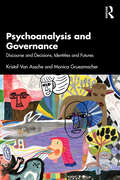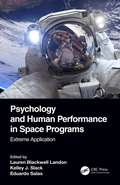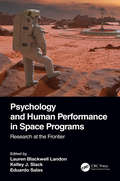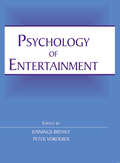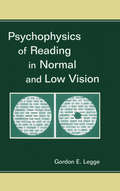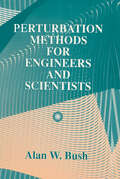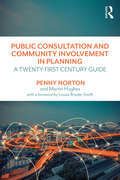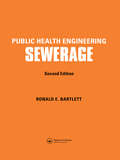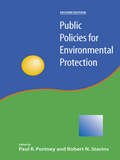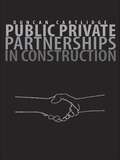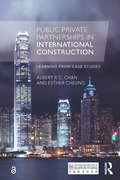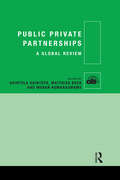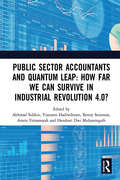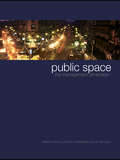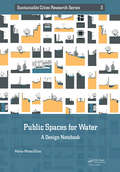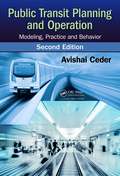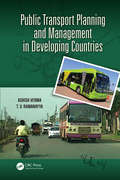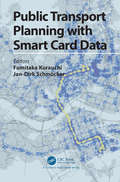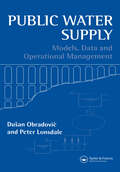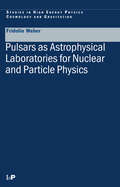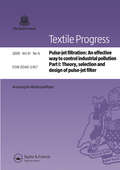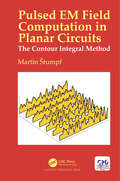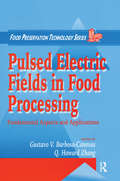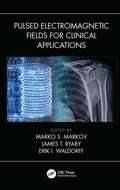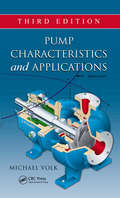- Table View
- List View
Psychoanalysis and Governance: Discourse and Decisions, Identities and Futures
by Kristof Van Assche Monica GruezmacherPsychoanalysis and Governance makes a cogent argument for the use of psychoanalytic perspectives in the understanding of governance, the process of collective decision-making that maintains and reshapes communities.This book is highly relevant to those interested in the ever-expanding field of applications of psychoanalysis and for all those willing to observe the discursive and affective underpinnings of public policy, administration, and planning. It locates the potential for self-analysis and self-transformation within governance, yet also indicates governance as the confluence of diverging understandings of the ideas of community and governance itself, as the place where competing desires and variegated patterns of fears and hopes collide and hold the transformational potential to destabilize the community.Building on Freudian, Lacanian, and other psychoanalytic traditions, the book enriches our understanding of governance, the way communities remember and forget, are haunted by the past, remain untransparent to themselves yet also retain the possibility of reinvention, of imagining alternative selves, new futures, and discover paths to move in that direction. This book will be a suitable for psychoanalysts, planners, and all those interested in informed governance.
Psychology and Human Performance in Space Programs: Extreme Application (Psychology and Human Performance in Space Programs, Two-Volume Set)
by Eduardo Salas Lauren Blackwell Landon Kelley J. SlackIn Psychology and Human Performance in Space Programs: Extreme Application, operations experts from multiple space agencies, with support from spaceflight researchers, outline existing and proposed operations for selecting, training, and supporting space crews who currently live and work on the International Space Station, and who are preparing for future missions to the moon and Mars. Highlighting applied psychology in spaceflight whilst acknowledging real-world complexities that occur when integrating across an international, multi-agency collective, this volume provides both historical and current perspectives toward spaceflight operations, with expert contributions from NASA and international partners such as the Japanese Space Agency, Russian space researchers, and the Canadian Space Agency. Helpfully outlining the progress that has been made so far, this book includes topics such as the selection and hiring of astronauts, the process of training a crew for a mission to Mars, and workload and mission planning. Discussing operational psychology in space and on the ground, this book looks to the future of research and operational needs for future missions to Mars, with an essay from astronaut Dr. Don Pettit on his experiences in space and how the Mars mission will challenge us in new ways.This second of two volumes will be of interest to professionals in the field of human factors and psychology in extreme environments.
Psychology and Human Performance in Space Programs: Research at the Frontier
by Lauren Blackwell Landon; Kelley J. Slack; Eduardo SalasIn Psychology and Human Performance in Space Programs: Research at the Frontier, leading space researchers from multiple fields of expertise summarize the recent growth of knowledge, the resulting tools and techniques, and the research still needed to protect humans in space. Making use of cutting-edge research and development related to composing, training, and supporting astronaut crews who will live and work together for future missions to Mars, this book examines the current practices of leaders in the field both at NASA and in academia. Presenting astronaut data alongside data from analogous extreme environments such as mission simulation habitats, this volume helpfully contrasts and compares to examine the lessons that can be learned from other approaches. Using the context of current International Space Station missions, the book discusses the influence of human factors and physiological health on individual and team job performance and social cohesion. With an overview of the physical and psychological hazards of space, and the challenges posed by conducting space-related applied psychology research, this volume uses the context of a long-duration Mars mission as a lens through which to discuss adaptation and resilience, technical and team training, technological advances related to working and living in space, and human interaction with onboard systems. Additionally, the book includes an essay from retired astronaut Clay Anderson on his experiences in space and thoughts on future missions to the moon and Mars. This first of two volumes will be of interest to professionals in the field of human factors and psychology at work, as well as academics examining human performance in extreme environments and aerospace.
Psychology of Entertainment: The Psychology Of Its Appeal (Routledge Communication Series)
by Jennings Bryant Peter VordererAs entertainment becomes a trillion-dollar-a-year industry worldwide, as our modern era increasingly lives up to its label of the "entertainment age," and as economists begin to recognize that entertainment has become the driving force of the new world economy, it is safe to say that scholars are beginning to take entertainment seriously. The scholarly spin on entertainment has been manifested in traditional ways, as well as innovative ones. Representing the current state of theory and research, Psychology of Entertainment promises to be the most comprehensive and up-to-date volume on entertainment. It serves to define the new area of study and provides a theoretical spin for future work in the area.Divided into three basic parts, this book:*addresses the fundamental mechanisms and processes involved in orienting to and selecting entertainment fare, as well as receiving and processing it;*explores the mechanisms and processes by which we are entertained by the media messages we select and receive; and*provides an opportunity for the application of well-established as well as emerging psychological and psychobiological theories to be applied to the study of entertainment in ways that seldom have been utilized previously.Psychology of Entertainment will appeal to scholars, researchers, and graduate students in media studies and mass communication, psychology, marketing, and other areas contributing to the entertainment studies area.
Psychophysics of Reading in Normal and Low Vision
by Gordon E. LeggeWritten by a leader in the field, this book discusses the role of vision in reading. The author describes the influence of physical properties of text on reading performance and the implications for information processing in the visual pathways. He explores different forms of low vision that affect reading, text characteristics that optimize reading for those with low vision, principles underlying the legibility of text, and guidelines for displaying text. Special topics include the role of the magnocellular pathway in reading and dyslexia, Braille reading, and fonts for highway signs. An accompanying CD contains reprints of the seminal series of articles by Gordon E. Legge and colleagues published between 1985 and 2001.
Psychotropic Bacteria in FoodsDisease and Spoilage
by Allen A. KraftPsychrotrophic Bacteria in Foods: Disease and Spoilage presents a comprehensive review of psychrotrophic bacteria and other pathogens and their role in causing food spoilage in refrigerated and frozen foods. The book focuses on the growth, survival, and subsequent activity of these organisms, especially in meat and poultry products. Metabolic produ
Public Consultation and Community Involvement in Planning: A twenty-first century guide
by Penny Norton Martin HughesPublic Consultation and Community Involvement in Planning is the definitive introduction to public consultation for developers, students and planners. The past decade has seen a complete transformation in consultation and community relations in the UK, from increased requirements to consult, to the introduction of neighbourhood planning and a revolution in online communication. Public Consultation and Community Involvement in Planning takes readers through consultation from the basics right through to emerging trends to demonstrate how a successful consultation process can benefit both the developers and the local community. The book begins with a definition of consultation and community involvement and an explanation of their role within the development process, before going on to clarify the legal, ethical, practical and ideological concerns to be addressed by the consultation process. Consultation strategy is explored step by step, and social media and online consultation is explored in detail. This is the first comprehensive guide to modern public consultation within the UK development sector and will be essential reading for developers, students and planners.
Public Health Engineering: Sewerage, Second Edition
by R.E. BartlettThis broad-based book covers topics in sewage treatment from site investigation through to design, construction and operation. Data and design charts are given in an appendix.
Public Policies for Environmental Protection
by Robert N. Stavins Paul Professor PortneyThe first edition of Public Policies for Environmental Protection contributed significantly to the incorporation of economic analysis in the study of environmental policy. Fully revised to account for changes in the institutional, legal, and regulatory framework of environmental policy, the second edition features updated chapters on the EPA and federal regulation, air and water pollution policy, and hazardous and toxic substances. It includes entirely new chapters on market-based environmental policies, global climate change, solid waste, and, for the first time, coverage of the Safe Drinking Water Act. Portney, Stavins, and their contributors provide an invaluable resource for researchers, policymakers, industry professionals, and journalists---anyone who needs up-to-date information on U.S. environmental policy. With their careful explanation of policy alternatives, the authors provide an ideal book for students in courses about environmental economics or environmental politics.
Public Private Partnerships in Construction
by Duncan CartlidgeCollaborative working and partnering between the public and private sectors has been fairly standard practice in some form or other for over 100 years, but it is only in recent years that it has become more prevalent. In the UK, it is little more than ten years since the most widely known Public Private Partnership (PPP), the Private Finance Initiative (PFI), was launched and yet it has already been described by some as 'the new economic paradigm.' Public Private Partnerships in Construction is an authoritative and objective source of information on PPPs, including lessons to be learnt from the past decade, as well as coverage of their spread beyond the UK to governments in areas as diverse as Cambodia and California. With its detailed presentation of current issues, illustrated with case studies, this book provides a valuable practical resource for a range of students and professionals.
Public Private Partnerships in International Construction: Learning from case studies
by Albert P. Chan Esther CheungOver the last ten years public private partnerships have become ever more popular worldwide, expanding the body of experience among construction professionals, government agencies, and industry. In these economically challenging times, PPP has emerged as a crucial framework for providing infrastructure, and also to boost construction industry activity, while shielding the taxpayer from some of the cost. Understanding the lessons learnt is essential to ensuring the success of future projects, and this timely book will prepare the reader to do just that. Starting by defining PPP itself, part one is designed to help the novice to get to grips with the basics of this topic. Part two tackles the practicalities of PPPs, including successful implementation, managing the risks involved, and how to assess the suitability of a project for the PPP route. Part three presents detailed case studies from Asia, Africa, and Australia to illustrate how PPPs should be managed, how problems emerge, and how PPPs can differ across the world. Drawing on extensive internationally conducted research, from both industry and academia, the authors have written the essential PPP guide. Taking into consideration the perspectives of those in the public sector and the private sector, as well as built environment professionals, it is essential reading for anyone preparing to work on public private partnerships in construction.
Public Private Partnerships: A Global Review
by Akintola Akintoye Matthias Beck Mohan KumaraswamyThis timely new book provides an international perspective on Public Private Partnerships. Through 21 case studies, it investigates the existing and fast developing body of principles and practices from a wide range of countries and is the first book to bring together leading international academics and practitioners under a common framework that enables convenient cross-country comparisons. The authors focus on the impact of the financial crisis has had on how governments have reviewed and overhauled their PPP policies as they have examined or tested new ways of partnering more effectively, efficiently and sustainably with the private sector. Readers will be able to gauge the level of maturity of PPP development in the book’s case studies, understand similarities and differences in their practices, and gain useful insights into the regulatory framework and institutional infrastructure in place to support implementation of PPP. Finally, the book offers insights into the future challenges and opportunities that PPP offers stakeholders.
Public Sector Accountants and Quantum Leap: Proceedings of the 1st International Conference on Public Sector Accounting (ICOPSA 2019), October 29-30, 2019, Jakarta, Indonesia
by Akhmad Solikin Yuniarto Hadiwibowo Benny Setiawan Amrie Firmansyah Hendrati Dwi MulyaningsihThe Industrial Revolution 4.0 will not only cause job losses, but will also create new workspaces that may not exist today. It also needs to be considered by accountants in government because the processes of budget planning, budget execution, and financial reporting have used a large number of information systems. In the era of the Industrial Revolution 4.0, the changes will be faster, marked by the emergence of such systems as supercomputers, smart robots, cloud computing, big data systems, genetic engineering and the development of neurotechnology that allows humans to optimize brain function further. Industrial Revolution 4.0 will disrupt the accounting profession. This proceedings provides selected papers/research on government accounting, accountability and integrity public sector accounting, financial accounting, accounting information system, auditing and assurance, corporate sustainability, forensic and management accounting, public and corporate finance, taxation and customs, open innovation in public sector accounting. The proceedings provide details beyond what is possible to be included in an oral presentation and constitute a concise but timely medium for the dissemination of recent research results. It will be invaluable to professionals and academics in the field of accounting, finance and the public sector to get an understanding of recent research.
Public Space: The Management Dimension
by Matthew Carmona Claudio De Magalhães Leo HammondIn both the UK and the US there is a sense of dissatisfaction and pessimism about the state of urban environments, particularly with the quality of everyday public spaces. Explanations for this have emphasized the poor quality of design that characterizes many new public spaces; spaces that are dominated by parking, roads infrastructure, introspective buildings, a lack of enclosure and a poor sense of place, and which in different ways for different groups are too often exclusionary. Yet many well designed public spaces have also experienced decline and neglect, as the services and activities upon which the continuing quality of those spaces have been subject to the same constraints and pressures for change as public services in general. These issues touch upon the daily management of public space, that is, the coordination of the many different activities that constantly define and redefine the characteristics and quality of public space. This book draws on three empirical projects to examine the questions of public space management on an international stage. They are set within a context of theoretical debates about public space, its history, contemporary patterns of use and changing nature in western society, and about the new management approaches that are increasingly being adopted.
Public Spaces for Water: A Design Notebook (Sustainable Cities Research Series #3)
by Maria Matos SilvaThis illustrated notebook highlights the need for a change of paradigm in current flood management practices, one that acknowledges the wide-ranging and interdisciplinary benefits brought by public space design. Reassessing and improving established flood management methods, public spaces are faced with a new and enhanced role as mediators of flood adaptation able to integrate infrastructure and communities together in the management of flood water as an ultimate resource for urban resilience. The book specifically introduces a path towards a new perspective on flood adaptation through public space design, stressing the importance of local, bottom up, approaches. Deriving from a solution-directed investigation, which is particularly attentive to design, the book offers a wide range of systematized conceptual solutions of flood adaptation measures applicable in the design of public spaces. Through a commonly used vocabulary and simple technical notions, the book facilitates and accelerates the initial brainstorm phases of a public space project with flood adaptation capacities, enabling a direct application in contemporary practice. Furthermore, it offers a significant sample of real-case examples that may further assist the decision-making throughout design processes. Overall, the book envisions to challenge established professionals, such as engineers, architects or urban planners, to work and design with uncertainty in an era of an unprecedented climate.
Public Transit Planning and Operation: Modeling, Practice and Behavior, Second Edition
by Avishai CederAddresses the Challenges Facing Public Transport Policy Makers and OperatorsPublic Transit Planning and Operation: Modeling, Practice and Behavior, Second Edition offers new solutions for delivering both better services and greater efficiency, solutions which have been developed and tested by the author in over thirty years of research work with ma
Public Transport Planning and Management in Developing Countries
by Ashish Verma T.V. RamanayyaDeveloping Countries Have Different Transportation Issues and Requirements Than Developed CountriesAn efficient transportation system is critical for a country's development. Yet cities in developing countries are typically characterized by high-density urban areas and poor public transport, as well as lack of proper roads, parking facilities, road
Public Transport Planning with Smart Card Data
by Fumitaka Kurauchi Jan-Dirk SchmöckerCollecting fares through "smart cards" is becoming standard in most advanced public transport networks of major cities around the world. Travellers value their convenience and operators the reduced money handling fees. Electronic tickets also make it easier to integrate fare systems, to create complex time and space differentiated fare systems, and to provide incentives to specific target groups. A less-utilised benefit is the data collected through smart cards. Records, even if anonymous, provide for a much better understanding of passengers’ travel behaviour as current literature shows. This information can also be used for better service planning. <P><P>Public Transport Planning with Smart Card Data handles three major topics: how passenger behaviour can be estimated using smart card data, how smart card data can be combined with other trip databases, and how the public transport service level can be better evaluated if smart card data is available. The book discusses theory as well as applications from cities around the world and will be of interest to researchers and practitioners alike who are interested in the state-of-the-art as well as future perspectives that smart card data will bring.
Public Water Supply: Models, Data and Operational Management
by Peter Lonsdale Dusan ObradovicProfessionals in the water supply industry are faced with a mass of technical information about how best to use new technologies to improve the efficiency of their supply operations.This book will help explain practical problems and potential solutions clearly and comprehensively to readers who may not be familiar with the latest developments in IT
Pulsars as Astrophysical Laboratories for Nuclear and Particle Physics (Series in High Energy Physics, Cosmology and Gravitation)
by Fridolin WeberPulsars, generally accepted to be rotating neutron stars, are dense, neutron-packed remnants of massive stars that blew apart in supernova explosions. They are typically about 10 kilometers across and spin rapidly, often making several hundred rotations per second. Depending on star mass, gravity compresses the matter in the cores of pulsars up to more than ten times the density of ordinary atomic nuclei, thus providing a high-pressure environment in which numerous particle processes, from hyperon population to quark deconfinement to the formation of Boson condensates, may compete with each other. There are theoretical suggestions of even more ""exotic"" processes inside pulsars, such as the formation of absolutely stable strange quark matter, a configuration of matter even more stable than the most stable atomic nucleus, ^T56Fe. In the latter event, pulsars would be largely composed of pure quark matter, eventually enveloped in nuclear crust matter.These features combined with the tremendous recent progress in observational radio and x-ray astronomy make pulsars nearly ideal probes for a wide range of physical studies, complementing the quest of the behavior of superdense matter in terrestrial collider experiments. Written by an eminent author, Pulsars as Astrophysical Laboratories for Nuclear and Particle Physics gives a reliable account of the present status of such research, which naturally is to be performed at the interface between nuclear physics, particle physics, and Einstein's theory of relativity.
Pulse-Jet Filtration: Part 1: Theory, Selection and Design of Pulse-Jet Filter
by Arunangshu MukhopadhyayThis book provides the fundamental concept of design and development of pulse-jet filters under varied situations. It discusses technical and commercial solutions for successful operation of textile industries integrated with pollution control equipment maintaining clean air requirements.
Pulsed EM Field Computation in Planar Circuits: The Contour Integral Method
by Martin StumpfThe pulsed EM characterization of planar circuits is of high practical importance in many areas of science and engineering such as electromagnetic compatibility and antenna design. This book is hence devoted to the mathematical formulation and numerical analysis of arbitrarily-shaped parallel-plane structures concerning their pulsed EM propagation, radiation and scattering behavior. The key emphasis is on the time-domain reciprocity-based integral-equation formulations and their efficient numerical solution.
Pulsed Electric Fields in Food Processing: Fundamental Aspects and Applications (Food Preservation Technology)
by Q. Howard Zhang Gustavo V. Barbosa-CanovasPulsed Electric Fields (PEF) is one of the nonthermal processing approaches that is receiving considerable attention by scientists, government and the food industry as a potential technique to be fully adopted to process foods at the industrial level. PEF presents a number of advantages including minimal changes to fresh foods, inactivation of a wi
Pulsed Electromagnetic Fields for Clinical Applications
by Marko S. Markov James T. Ryaby Erik I. WaldorffPulsed Electromagnetic Fields for Clinical Applications presents the historical development, the state of art, and the future of the application of pulsed electromagnetic fields (PEMFs) for the treatment of various medical problems, including initiating various healing processes from delayed fractures and pain relief to multiple sclerosis and Parkinson’s disease. The emphasis is on the development of scientific methods to be implemented in clinical application. In perspective, this modality provides a practical, exogenous method for inducing cell and tissue modification attempted to the injured tissues to their normal physiological status. The book reviews the current state of equipment for PEMFs and highlights worldwide therapeutic achievements. It explores the past, present, and future of PEMF therapies. It presents the development of theory and laboratory research during the last 70 years. It reviews the available equipment for PEMF. It reviews the state of the art of worldwide therapeutic achievements. It includes recent achievements and applications of electroporation modalities.
Pump Characteristics and Applications (Mechanical Engineering)
by Michael VolkProviding a wealth of information on pumps and pump systems, Pump Characteristics and Applications, Third Edition details how pump equipment is selected, sized, operated, maintained, and repaired. The book identifies the key components of pumps and pump accessories, introduces the basics of pump and system hydraulics as well as more advanced hydrau
